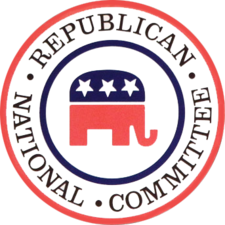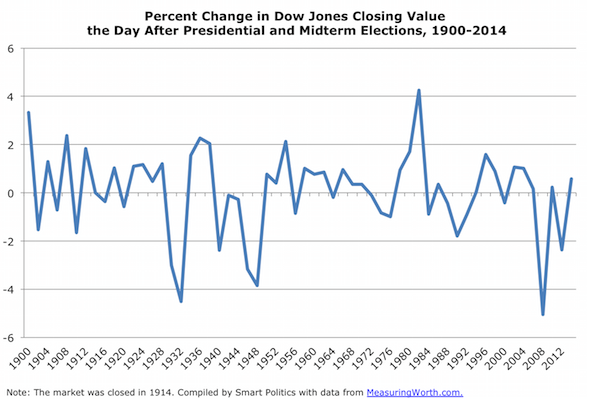The Day After: How the Dow Jones ‘Reacts’ to Election Day Results
Gains in the stock market last Wednesday after the GOP wave were only slightly above the historical average; the biggest day-after drops in the market have occurred after the election of Democratic presidents
 At the close of markets last Wednesday, the Dow Jones finished up 100.69 points, one day after Republicans won enough seats to take back control of the U.S. Senate in 2015 and expand their advantage in the House of Representatives by double-digits.
At the close of markets last Wednesday, the Dow Jones finished up 100.69 points, one day after Republicans won enough seats to take back control of the U.S. Senate in 2015 and expand their advantage in the House of Representatives by double-digits.
The 100-point gain marked only the second time in history that Dow Jones enjoyed triple-digit gains the day after a U.S. presidential or midterm election – just slightly behind the 101.32 rise after George W. Bush was reelected in 2004.
On the surface, that seems like a Wall Street endorsement of the electoral results.
However, with the market north of 17,000 these days, there was perhaps less to the market gains than meets the eye.
Smart Politics examined the Dow Jones Industrial Average closing values on the Wednesday after Election Day going back to 1900 and found that the bump on November 5, 2014 was only the 25th biggest increase across the last 57 cycles.
(Note: DJIA Data was retrieved from Measuring Worth).
Overall, markets have risen after Election Day more often than not since the turn of the 20th Century, with the DJIA up after 33 elections and down after 24.
In 2014, the Dow Jones increased 0.58 percent from the close Tuesday (17,383) to Wednesday (17,484) which ranks 25th out of 57 cycles since 1900. (The New York Stock Market was closed for nearly four and one-half months in 1914 including weeks before and after the election).
The biggest bump in the market came after the 1982 midterms, when Democrats wiped out most of the large GOP gains in the U.S. House two years prior when Ronald Reagan was elected president.
The DJIA increased 4.25 percent on Wednesday, November 3, 1982 – rising from 1,022 to 1,065.
All other cycles with market gains of two percent or larger on the day after the election took place 60 or more years ago:
● 1900: +3.33 percent
● 1908: +2.38 percent
● 1936: +2.26 percent
● 1954: +2.13 percent
And which cycle saw the biggest drop in the market after Election Day?
That came after the election of Barack Obama in 2008 which also saw Democratic gains of 21 U.S. House seats and eight seats in the U.S. Senate.
The DJIA fell 486 points that Wednesday, losing 5.05 percent of its value from 9,625 to 9,139.
To be sure, markets had already fallen substantially in 2008 prior to Election Day (dropping 27.4 percent since January 1st), which no doubt aided the Democrats in their gains that cycle, though the Dow Jones had enjoyed a sharp 3.28 percent increase on Election Day, November 4th.
To the extent markets ‘respond’ at all to Election Day results, the Dow Jones has generally lost value the day after the election of Democratic presidential nominees. (Note: The data here is merely correlative, as there are more forces than simple electoral politics driving gains and losses in the market on any given day, even the day after an election).
Overall, the market has fallen by an average of 1.03 percent the day after the election of a Democratic president since 1900 – down in 10 cycles (1916, 1932, 1940, 1944, 1948, 1964, 1976, 1992, 2008, 2012) and up in just four (1912, 1936, 1960, 1996).
By contrast, the DJIA has increased an average of 0.64 percent on the day after the election of Republican presidents – up in nine cycles (1900, 1904, 1908, 1924, 1928, 1952, 1968, 1980, 2004) and down in six (1920, 1956, 1972, 1984, 1988, 2000).
In fact, five of the biggest seven post-Election Day market losses came after the election of a Democratic president:
● #1 = 2008 (Obama): -5.05 percent
● #2 = 1932 (FDR): -4.51 percent
● #3 = 1948 (Truman): -3.85 percent
● #6 = 1940 (FDR): -2.39 percent
● #7 = 2012 (Obama): = -2.36 percent
The other two post-Election Day losses that saw the market shed at least two percent of its value came in 1930 after big Democratic gains (+52 House, +8 Senate) and in 1946 after large Republican gains (+55 House, +13 Senate).
Follow Smart Politics on Twitter.


Look at how the DOW has performed historically under the parties. The first day after an election is driven by individuals with hyper partisanized views of things either way, but the long term prospects clearly look far better with Democrats in office.